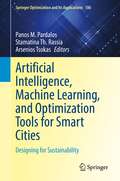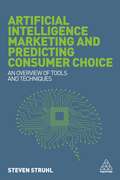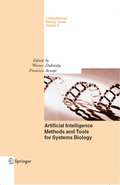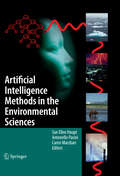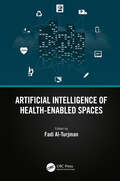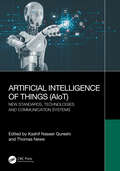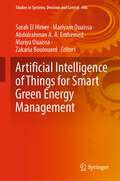- Table View
- List View
Artificial Intelligence, Machine Learning, and Optimization Tools for Smart Cities: Designing for Sustainability (Springer Optimization and Its Applications #186)
by Panos M. Pardalos Stamatina Th. Rassia Arsenios TsokasThis volume offers a wealth of interdisciplinary approaches to artificial intelligence, machine learning and optimization tools, which contribute to the optimization of urban features towards forming smart, sustainable, and livable future cities.Special features include:New research on the design of city elements and smart systems with respect to new technologies and scientific thinkingDiscussions on the theoretical background that lead to smart cities for the futureNew technologies and principles of research that can promote ideas of artificial intelligence and machine learning in optimized urban environmentsThe book engages students and researchers in the subjects of artificial intelligence, machine learning, and optimization tools in smart sustainable cities as eminent international experts contribute their research results and thinking in its chapters. Overall, its audience can benefit from a variety of disciplines including, architecture, engineering, physics, mathematics, computer science, and related fields.
Artificial Intelligence Marketing and Predicting Consumer Choice: An Overview of Tools and Techniques
by Dr Steven StruhlThe ability to predict consumer choice is a fundamental aspect to success for any business. In the context of artificial intelligence marketing, there are a wide array of predictive analytic techniques available to achieve this purpose, each with its own unique advantages and disadvantages. Artificial Intelligence Marketing and Predicting Consumer Choice serves to integrate these widely disparate approaches, and show the strengths, weaknesses, and best applications of each. It provides a bridge between the person who must apply or learn these problem-solving methods and the community of experts who do the actual analysis. It is also a practical and accessible guide to the many remarkable advances that have been recently made in this fascinating field. Online resources: bonus chapters on AI, ensembles and neural nets, and finishing experiments, plus single and multiple product simulators.
Artificial Intelligence Marketing and Predicting Consumer Choice: An Overview of Tools and Techniques
by Dr Steven StruhlThe ability to predict consumer choice is a fundamental aspect to success for any business. In the context of artificial intelligence marketing, there are a wide array of predictive analytic techniques available to achieve this purpose, each with its own unique advantages and disadvantages. Artificial Intelligence Marketing and Predicting Consumer Choice serves to integrate these widely disparate approaches, and show the strengths, weaknesses, and best applications of each. It provides a bridge between the person who must apply or learn these problem-solving methods and the community of experts who do the actual analysis. It is also a practical and accessible guide to the many remarkable advances that have been recently made in this fascinating field. Online resources: bonus chapters on AI, ensembles and neural nets, and finishing experiments, plus single and multiple product simulators.
Artificial Intelligence Methods and Tools for Systems Biology (Computational Biology #5)
by Francisco Azuaje W. DubitzkyThis book provides simultaneously a design blueprint, user guide, research agenda, and communication platform for current and future developments in artificial intelligence (AI) approaches to systems biology. It places an emphasis on the molecular dimension of life phenomena and in one chapter on anatomical and functional modeling of the brain. As design blueprint, the book is intended for scientists and other professionals tasked with developing and using AI technologies in the context of life sciences research. As a user guide, this volume addresses the requirements of researchers to gain a basic understanding of key AI methodologies for life sciences research. Its emphasis is not on an intricate mathematical treatment of the presented AI methodologies. Instead, it aims at providing the users with a clear understanding and practical know-how of the methods. As a research agenda, the book is intended for computer and life science students, teachers, researchers, and managers who want to understand the state of the art of the presented methodologies and the areas in which gaps in our knowledge demand further research and development. Our aim was to maintain the readability and accessibility of a textbook throughout the chapters, rather than compiling a mere reference manual. The book is also intended as a communication platform seeking to bride the cultural and technological gap among key systems biology disciplines. To support this function, contributors have adopted a terminology and approach that appeal to audiences from different backgrounds.
Artificial Intelligence Methods in Intelligent Algorithms: Proceedings of 8th Computer Science On-line Conference 2019, Vol. 2 (Advances in Intelligent Systems and Computing #985)
by Radek SilhavyThis book discusses the current trends in and applications of artificial intelligence research in intelligent systems. Including the proceedings of the Artificial Intelligence Methods in Intelligent Algorithms Section of the 8th Computer Science On-line Conference 2019 (CSOC 2019), held in April 2019, it features papers on neural networks algorithms, optimisation algorithms and real-world issues related to the application of artificial methods.
Artificial Intelligence Methods in the Environmental Sciences
by Sue Ellen Haupt Antonello Pasini Caren MarzbanHow can environmental scientists and engineers use the increasing amount of available data to enhance our understanding of planet Earth, its systems and processes? This book describes various potential approaches based on artificial intelligence (AI) techniques, including neural networks, decision trees, genetic algorithms and fuzzy logic. Part I contains a series of tutorials describing the methods and the important considerations in applying them. In Part II, many practical examples illustrate the power of these techniques on actual environmental problems. International experts bring to life ways to apply AI to problems in the environmental sciences. While one culture entwines ideas with a thread, another links them with a red line. Thus, a “red thread“ ties the book together, weaving a tapestry that pictures the ‘natural’ data-driven AI methods in the light of the more traditional modeling techniques, and demonstrating the power of these data-based methods.
Artificial Intelligence: A New Synthesis
by Nils J. NilssonIntelligent agents are employed as the central characters in this introductory text. Beginning with elementary reactive agents, Nilsson gradually increases their cognitive horsepower to illustrate the most important and lasting ideas in AI. Neural networks, genetic programming, computer vision, heuristic search, knowledge representation and reasoning, Bayes networks, planning, and language understanding are each revealed through the growing capabilities of these agents. A distinguishing feature of this text is in its evolutionary approach to the study of AI. This book provides a refreshing and motivating synthesis of the field by one of AI's master expositors and leading researches.An evolutionary approach provides a unifying themeThorough coverage of important AI ideas, old and newFrequent use of examples and illustrative diagramsExtensive coverage of machine learning methods throughout the textCitations to over 500 referencesComprehensive index
Artificial Intelligence of Health-Enabled Spaces
by Fadi Al-TurjmanArtificial Intelligence of Health-Enabled Spaces (AIoH) has made a number of revolutionary advances in clinical studies that we are aware of. Among these advances, intelligent and medical services are gaining a great deal of interest. Nowadays, AI-powered technologies are not only used in saving lives, but also in our daily life activities in diagnosing, controlling, and even tracking of COVID-19 patients. These AI-powered solutions are expected to communicate with cellular networks smoothly in the next-generation networks (5G/6G and beyond) for more effective/critical medical applications. This will open the door for other interesting research areas. This book focuses on the development and analysis of artificial intelligence (AI) model applications across multiple disciplines. AI-based deep learning models, fuzzy and hybrid intelligent systems, and intrinsic explainable models are also presented in this book. Some of the fields considered in this smart health-oriented book include AI applications in electrical engineering, biomedical engineering, environmental engineering, computer engineering, education, cyber security, chemistry, pharmacy, molecular biology, and tourism. This book is dedicated to addressing the major challenges in fighting diseases and psychological issues using AI. These challenges vary from cost and complexity to availability and accuracy. The aim of this book is hence to focus on both the design and implementation aspects of AI-based approaches in the proposed health-related solutions. Targeted readers are from varying disciplines who are interested in implementing the smart planet/environments vision via intelligent enabling technologies.
Artificial Intelligence of Health-Enabled Spaces
Artificial Intelligence of Health-Enabled Spaces (AIoH) has made a number of revolutionary advances in clinical studies that we are aware of. Among these advances, intelligent and medical services are gaining a great deal of interest. Nowadays, AI-powered technologies are not only used in saving lives, but also in our daily life activities in diagnosing, controlling, and even tracking of COVID-19 patients. These AI-powered solutions are expected to communicate with cellular networks smoothly in the next-generation networks (5G/6G and beyond) for more effective/critical medical applications. This will open the door for other interesting research areas. This book focuses on the development and analysis of artificial intelligence (AI) model applications across multiple disciplines. AI-based deep learning models, fuzzy and hybrid intelligent systems, and intrinsic explainable models are also presented in this book. Some of the fields considered in this smart health-oriented book include AI applications in electrical engineering, biomedical engineering, environmental engineering, computer engineering, education, cyber security, chemistry, pharmacy, molecular biology, and tourism. This book is dedicated to addressing the major challenges in fighting diseases and psychological issues using AI. These challenges vary from cost and complexity to availability and accuracy. The aim of this book is hence to focus on both the design and implementation aspects of AI-based approaches in the proposed health-related solutions. Targeted readers are from varying disciplines who are interested in implementing the smart planet/environments vision via intelligent enabling technologies.
Artificial Intelligence of Things: First International Conference, ICAIoT 2023, Chandigarh, India, March 30–31, 2023, Revised Selected Papers, Part I (Communications in Computer and Information Science #1929)
by Rama Krishna Challa Gagangeet Singh Aujla Lini Mathew Amod Kumar Mala Kalra S. L. Shimi Garima Saini Kanika SharmaThese two volumes constitute the revised selected papers of First International Conference, ICAIoT 2023, held in Chandigarh, India, during March 30–31, 2023.The 47 full papers and the 10 short papers included in this volume were carefully reviewed and selected from 401 submissions. The two books focus on research issues, opportunities and challenges of AI and IoT applications. They present the most recent innovations, trends, and concerns as well as practical challenges encountered and solutions adopted in the fields of AI algorithms implementation in IoT Systems
Artificial Intelligence of Things: First International Conference, ICAIoT 2023, Chandigarh, India, March 30–31, 2023, Revised Selected Papers, Part II (Communications in Computer and Information Science #1930)
by Rama Krishna Challa Gagangeet Singh Aujla Lini Mathew Amod Kumar Mala Kalra S. L. Shimi Garima Saini Kanika SharmaThese two volumes constitute the revised selected papers of First International Conference, ICAIoT 2023, held in Chandigarh, India, during March 30–31, 2023.The 47 full papers and the 10 short papers included in this volume were carefully reviewed and selected from 401 submissions. The two books focus on research issues, opportunities and challenges of AI and IoT applications. They present the most recent innovations, trends, and concerns as well as practical challenges encountered and solutions adopted in the fields of AI algorithms implementation in IoT Systems
Artificial Intelligence of Things (AIoT): New Standards, Technologies and Communication Systems
by Kashif Naseer Qureshi Thomas NeweThis book is devoted to the new standards, technologies, and communication systems for Artificial Intelligence of Things (AIoT) networks. Smart and intelligent communication networks have gained significant attention due to the combination of AI and IoT networks to improve human and machine interfaces and enhance data processing and services. AIoT networks involve the collection of data from several devices and sensor nodes in the environment. AI can enhance these networks to make them faster, greener, smarter, and safer. Computer vision, language processing, and speech recognition are some examples of AIoT networks.Due to a large number of devices in today’s world, efficient and intelligent data processing is essential for problem-solving and decision-making. AI multiplies the value of these networks and promotes intelligence and learning capabilities, especially in homes, offices, and cities. However, several challenges have been observed in deploying AIoT networks, such as scalability, complexity, accuracy, and robustness. In addition, these networks are integrated with cloud, 5G networks, and blockchain methods for service provision. Many different solutions have been proposed to address issues related to machine and deep learning methods, ontology-based approaches, genetic algorithms, and fuzzy-based systems.This book aims to contribute to the state of the art and present current standards, technologies, and approaches for AIoT networks. This book focuses on existing solutions in AIoT network technologies, applications, services, standards, architectures, and security provisions. This book also introduces some new architectures and models for AIoT networks.
Artificial Intelligence of Things (AIoT): New Standards, Technologies and Communication Systems
This book is devoted to the new standards, technologies, and communication systems for Artificial Intelligence of Things (AIoT) networks. Smart and intelligent communication networks have gained significant attention due to the combination of AI and IoT networks to improve human and machine interfaces and enhance data processing and services. AIoT networks involve the collection of data from several devices and sensor nodes in the environment. AI can enhance these networks to make them faster, greener, smarter, and safer. Computer vision, language processing, and speech recognition are some examples of AIoT networks.Due to a large number of devices in today’s world, efficient and intelligent data processing is essential for problem-solving and decision-making. AI multiplies the value of these networks and promotes intelligence and learning capabilities, especially in homes, offices, and cities. However, several challenges have been observed in deploying AIoT networks, such as scalability, complexity, accuracy, and robustness. In addition, these networks are integrated with cloud, 5G networks, and blockchain methods for service provision. Many different solutions have been proposed to address issues related to machine and deep learning methods, ontology-based approaches, genetic algorithms, and fuzzy-based systems.This book aims to contribute to the state of the art and present current standards, technologies, and approaches for AIoT networks. This book focuses on existing solutions in AIoT network technologies, applications, services, standards, architectures, and security provisions. This book also introduces some new architectures and models for AIoT networks.
Artificial Intelligence of Things for Achieving Sustainable Development Goals (Lecture Notes on Data Engineering and Communications Technologies #192)
by Sanjay Misra Kerstin Siakas Georgios LampropoulosThis book covers various topics and trends regarding Artificial Intelligence (AI), Internet of Things (IoT), and their applications in society, industry, and environment for achieving Sustainable Development Goals (SDGs) suggested by the United Nations. Additionally, it discusses their advancements and fusion as well as the realization of Artificial Intelligence of Things (AIoT). The book aims to provide an overview and recent research into the fusion, integration, advancements, and impact of these technologies in the context of SDGs achievement. The topics include the applications of AI, IoT, big data, AI-based and IoT-based cloud computing, machine learning and deep learning techniques, and blockchain among others for achieving SDGs. It also presents findings and discussions on potential application domains, addresses open issues and challenges, offers solutions, and provides suggestions for future research for achieving SDGs. The chapters are clustered, according to particular SDGsor areas of focus, into: i) the realization of AIoT for SDGs, ii) the role of AIoT in achieving society and wellbeing-related SDGs, iii) the fulfillment of industrial sectors, infrastructure, and economy-related SDGs through AIoT, and iv) the use of AIoT to aid natural resources and environment-related SDGs. The book assists researchers, practitioners, professionals, and academicians of various scientific fields in exploring and better understanding these state-of-the-art technologies, their advancements, impact, future potentials and benefits, and their role in successfully achieving SDGs.The book:· Offers an in-depth overview of AIoT for achieving SDGs.· Presents the fusion of AI and IoT for bringing a significant change in everyday life and fulfilling SDGs.· Highlights innovative solutions and results of AIoT integration in several domains for achieving SDGs.· Showcases the influence of AIoT on promoting and improving sustainability in the context of SDGs.· Discusses the issues, benefits, solutions, and impact of AIoT in society, industry, and environment for achieving SDGs.
Artificial Intelligence of Things for Smart Green Energy Management (Studies in Systems, Decision and Control #446)
by Sarah El Himer Mariyam Ouaissa Abdulrahman A. A. Emhemed Mariya Ouaissa Zakaria BoulouardThis book is intended to assist in the development of smart and efficient green energy solutions. It introduces energy systems, power generation, and power demands which able to minimise generation costs, power loss or environmental effects. It proposes cutting-edge solutions and approaches based on recent technologies such as intelligent renewable energy systems (wind and solar). These solutions, applied to different sectors, can provide a solid basis for meeting the needs of both developed and developing countries. The book provides a collection of contributions including new techniques, methods, algorithms, practical solutions and models based on applying artificial intelligence and the Internet of things into green energy management systems. It provides a comprehensive reference for researchers, scholars and industry in the field of green energy and computational intelligence.
Artificial Intelligence on Dark Matter and Dark Energy: Reverse Engineering of the Big Bang (Chapman & Hall/CRC Artificial Intelligence and Robotics Series)
by Ariel FernándezAs we prod the cosmos at very large scales, basic tenets of physics seem to crumble under the weight of contradicting evidence. This book helps mitigate the crisis. It resorts to artificial intelligence (AI) for answers and describes the outcome of this quest in terms of an ur-universe, a quintessential compact multiply connected space that incorporates a fifth dimension to encode space-time as a latent manifold. In some ways, AI is bolder than humans because the huge corpus of knowledge, starting with the prodigious Standard Model (SM) of particle physics, poses almost no burden to its conjecture-framing processes. Why not feed AI with the SM enriched by the troubling cosmological phenomenology on dark matter and dark energy and see where AI takes us vis-à-vis reconciling the conflicting data with the laws of physics? This is precisely the intellectual adventure described in this book and – to the best of our knowledge – in no other book on the shelf. As the reader will discover, many AI conjectures and validations ultimately make a lot of sense, even if their boldness does not feel altogether "human" yet. This book is written for a broad readership. Prerequisites are minimal, but a background in college math/physics/computer science is desirable. This book does not merely describe what is known about dark matter and dark energy but also provides readers with intellectual tools to engage in a quest for the deepest cosmological mystery.
Artificial Intelligence on Dark Matter and Dark Energy: Reverse Engineering of the Big Bang (Chapman & Hall/CRC Artificial Intelligence and Robotics Series)
by Ariel FernándezAs we prod the cosmos at very large scales, basic tenets of physics seem to crumble under the weight of contradicting evidence. This book helps mitigate the crisis. It resorts to artificial intelligence (AI) for answers and describes the outcome of this quest in terms of an ur-universe, a quintessential compact multiply connected space that incorporates a fifth dimension to encode space-time as a latent manifold. In some ways, AI is bolder than humans because the huge corpus of knowledge, starting with the prodigious Standard Model (SM) of particle physics, poses almost no burden to its conjecture-framing processes. Why not feed AI with the SM enriched by the troubling cosmological phenomenology on dark matter and dark energy and see where AI takes us vis-à-vis reconciling the conflicting data with the laws of physics? This is precisely the intellectual adventure described in this book and – to the best of our knowledge – in no other book on the shelf. As the reader will discover, many AI conjectures and validations ultimately make a lot of sense, even if their boldness does not feel altogether "human" yet. This book is written for a broad readership. Prerequisites are minimal, but a background in college math/physics/computer science is desirable. This book does not merely describe what is known about dark matter and dark energy but also provides readers with intellectual tools to engage in a quest for the deepest cosmological mystery.
Artificial Intelligence on Fashion and Textiles: Proceedings of the Artificial Intelligence on Fashion and Textiles (AIFT) Conference 2018, Hong Kong, July 3–6, 2018 (Advances in Intelligent Systems and Computing #849)
by Wai Keung WongThe book includes the Proceedings of the Artificial Intelligence on Fashion and Textiles conference 2018 which provides state-of-the-art techniques and applications of AI in the fashion and textile industries. It is essential reading for scientists, researchers and R&D professionals working in the field of AI with applications in the fashion and textile industry; managers in the fashion and textile enterprises; and anyone with an interest in the applications of AI. Over the last two decades, with the great advancement of computer technology, academic research in artificial intelligence (AI) and its applications in fashion and textile supply chain has been becoming a very hot topic and has received greater attention from both academics and industrialists. A number of AI-related techniques has been successfully employed and proven to handle the problems including fashion sales forecasting, supply chain optimization, planning and scheduling, textile material defect detection, fashion and textile image recognition, fashion image and style retrieval, human body modeling and fitting, etc.
Artificial Intelligence on Medical Data: Proceedings of International Symposium, ISCMM 2021 (Lecture Notes in Computational Vision and Biomechanics #37)
by Mousumi Gupta Sujata Ghatak Amlan Gupta Abir Lal MukherjeeThis book includes high-quality papers presented at the Second International Symposium on Computer Vision and Machine Intelligence in Medical Image Analysis (ISCMM 2021), organized by Computer Applications Department, SMIT in collaboration with Department of Pathology, SMIMS, Sikkim, India, and funded by Indian Council of Medical Research, during 11 – 12 November 2021. It discusses common research problems and challenges in medical image analysis, such as deep learning methods. It also discusses how these theories can be applied to a broad range of application areas, including lung and chest x-ray, breast CAD, microscopy and pathology. The studies included mainly focus on the detection of events from biomedical signals.
Artificial Intelligence over Infrared Images for Medical Applications: Second MICCAI Workshop, AIIIMA 2023, Held in Conjunction with MICCAI 2023, Vancouver, BC, Canada, October 2, 2023, Proceedings (Lecture Notes in Computer Science #14298)
by Siva Teja Kakileti Geetha Manjunath Robert G. Schwartz Alejandro F. FrangiThis book constitutes the refereed proceedings of the Second Workshop on Artificial Intelligence over Infrared Images for Medical Applications, AIIIMA 2023 held in conjunction with MICCAI 2023, held in Vancouver, BC, Canada, on October 2, 2023. The 10 full papers presented in this book were carefully peer reviewed and selected from 15 submissions. The second workshop on AIIIMA, similarily to the first, aimes to create a forum to discuss the specific sub-topic of AI over Infrared Images for Medical Applications at MICCAI and promote this novel area of research, that has the potential to hugely impact our society, among the research community.
Artificial Intelligence over Infrared Images for Medical Applications and Medical Image Assisted Biomarker Discovery: First MICCAI Workshop, AIIIMA 2022, and First MICCAI Workshop, MIABID 2022, Held in Conjunction with MICCAI 2022, Singapore, September 18 and 22, 2022, Proceedings (Lecture Notes in Computer Science #13602)
by Alejandro F. Frangi Robert G. Schwartz Geetha Manjunath Michal Rosen-Zvi Maria Gabrani Christopher Weight Siva Teja Kakileti Nathaniel Braman Pau-Choo Chung Vekataraman JagadishThis book constitutes the refereed proceedings of the First Workshop on Artificial Intelligence over Infrared Images for Medical Applications, AIIIMA 2022, and the First Workshop on Medical Image Assisted Biomarker Discovery, MIABID 2022, both held in conjunction with MICCAI 2022, Singapore, during September 18 and 22, 2022.For MIABID 2022, 7 papers from 10 submissions were accepted for publication. This workshop created a forum to discuss this specific sub-topic at MICCAI and promote this novel area of research among the research community that has the potential to hugely impact our society.For AIIIMA 2022, 10 papers from 15 submissions were accepted for publication. The first workshop on AIIIMA aimed to create a forum to discuss this specific sub-topic of AI over Infrared Images for Medical Applications at MICCAI and promote this novel area of research that has the potential to hugely impact our society, among the research community.
Artificial Intelligence Perspective for Smart Cities
by Vahap Tecim Sezer Bozkus KahyaogluThe concept of a "smart city" is used widely in general; however, it is hard to explain because of the complexity and multidimensionality of this notion. However, the essential qualification for being a smart city is to achieve "sustainable social, environmental, and economic development" and boost the living standards of society based on Information and Communication Technology (ICT) and Artificial intelligence (AI). AI in smart cities has become an important aspect for cities that face great challenges to make smart decisions for social well-being, particularly cybersecurity and corporate sustainability. In this context, we aim to contribute literature with a value-added approach where various AI applications of smart cities are discussed from a different perspective. First, we start by discussing the conceptual design, modeling, and determination of components for the sustainability of a smart city structure. Since smart cities operate on spatial-based data, it is important to design, operate, and manage smart city elements using Geographical Information Systems (GIS) technologies. Second, we define the structure, type, unit, and functionality of the layers to be placed on the GIS to achieve best practices based on Industry 4.0 components. Transportation is one of the key indicators of smart cities, so it is critical to make transportation in smart cities accessible for different disabled groups by using AI technologies. Third, we demonstrate what kinds of technologies should be used for which disabled groups in different transportation vehicles with specific examples. Finally, we create a discussion platform for processes and sub-processes such as waste management, emergency management, risk management, and data management for establishing smart cities including the financial and ethical aspects.
Artificial Intelligence Perspective for Smart Cities
by Vahap Tecim Sezer Bozkus KahyaogluThe concept of a "smart city" is used widely in general; however, it is hard to explain because of the complexity and multidimensionality of this notion. However, the essential qualification for being a smart city is to achieve "sustainable social, environmental, and economic development" and boost the living standards of society based on Information and Communication Technology (ICT) and Artificial intelligence (AI). AI in smart cities has become an important aspect for cities that face great challenges to make smart decisions for social well-being, particularly cybersecurity and corporate sustainability. In this context, we aim to contribute literature with a value-added approach where various AI applications of smart cities are discussed from a different perspective. First, we start by discussing the conceptual design, modeling, and determination of components for the sustainability of a smart city structure. Since smart cities operate on spatial-based data, it is important to design, operate, and manage smart city elements using Geographical Information Systems (GIS) technologies. Second, we define the structure, type, unit, and functionality of the layers to be placed on the GIS to achieve best practices based on Industry 4.0 components. Transportation is one of the key indicators of smart cities, so it is critical to make transportation in smart cities accessible for different disabled groups by using AI technologies. Third, we demonstrate what kinds of technologies should be used for which disabled groups in different transportation vehicles with specific examples. Finally, we create a discussion platform for processes and sub-processes such as waste management, emergency management, risk management, and data management for establishing smart cities including the financial and ethical aspects.
Artificial Intelligence Perspectives and Applications: Proceedings of the 4th Computer Science On-line Conference 2015 (CSOC2015), Vol 1: Artificial Intelligence Perspectives and Applications (Advances in Intelligent Systems and Computing #347)
by Radek Silhavy Roman Senkerik Zuzana Kominkova Oplatkova Zdenka Prokopova Petr SilhavyThis volume is based on the research papers presented in the 4th Computer Science On-line Conference.The volume Artificial Intelligence Perspectives and Applications presents new approaches and methods to real-world problems, and in particular, exploratory research that describes novel approaches in the field of artificial intelligence. Particular emphasis is laid on modern trends in selected fields of interest. New algorithms or methods in a variety of fields are also presented.The Computer Science On-line Conference (CSOC 2015) is intended to provide an international forum for discussions on the latest high-quality research results in all areas related to Computer Science.The addressed topics are the theoretical aspects and applications of Computer Science, Artificial Intelligences, Cybernetics, Automation Control Theory and Software Engineering.
Artificial Intelligence Perspectives in Intelligent Systems: Proceedings of the 5th Computer Science On-line Conference 2016 (CSOC2016), Vol 1 (Advances in Intelligent Systems and Computing #464)
by Radek Silhavy Roman Senkerik Zuzana Kominkova Oplatkova Petr Silhavy Zdenka ProkopovaThis volume is based on the research papers presented in the 5th Computer Science On-line Conference.The volume Artificial Intelligence Perspectives in Intelligent Systems presents modern trends and methods to real-world problems, and in particular, exploratory research that describes novel approaches in the field of artificial intelligence. New algorithms in a variety of fields are also presented.The Computer Science On-line Conference (CSOC 2016) is intended to provide an international forum for discussions on the latest research results in all areas related to Computer Science.The addressed topics are the theoretical aspects and applications of Computer Science, Artificial Intelligences, Cybernetics, Automation Control Theory and Software Engineering.
